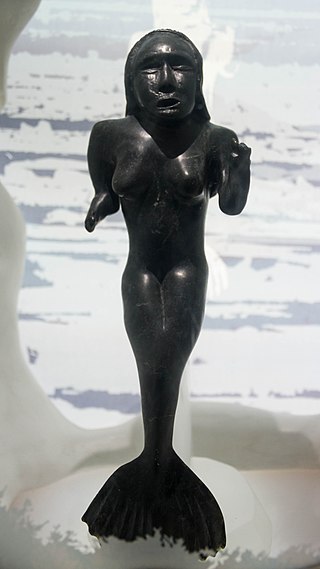Related Research Articles

This is a demography of the population of Greenland including population density, ethnicity, economic status, religious affiliations and other aspects of the population.

Inuit religion is the shared spiritual beliefs and practices of the Inuit, an indigenous people from Alaska, northern Canada, parts of Siberia and Greenland. Their religion shares many similarities with some Alaska Native religions. Traditional Inuit religious practices include animism and shamanism, in which spiritual healers mediate with spirits. Today many Inuit follow Christianity ; however, traditional Inuit spirituality continues as part of a living, oral tradition and part of contemporary Inuit society. Inuit who balance indigenous and Christian theology practice religious syncretism.
In Inuit religion, Nanook was the master of bears, meaning he decided if hunters deserved success in finding and hunting bears and punished violations of taboos. The word was popularized by Nanook of the North, the first feature-length documentary.
In Inuit mythology, Tulugaak was the creator of light. The meaning of tulugaq is 'raven'; cf. the god Tuluŋigraq.
In Inuit mythology, an inua is a spirit or soul that exists in all people, animals, lakes, mountains, and plants. This is not an individual soul, but rather "the vital force representing a chain or continuum of all the individual spirits of that genus which had lived, were living, or were to live."
In Inuit mythology, Tarqiup Inua is a lunar deity.
Qiqirn is a large, bald dog spirit in Inuit mythology, from around the area of Baffin Island. It has hair only on its feet, mouth and the tips of its ears and tail. Its presence will send men and dogs into convulsions, sometimes fatal. However, it is frightened of humans and will run away if an angakkuq sees it. A similar term, also from Inuit mythology, is keelut, a malevolent earth spirit which also appears as a hairless dog.
The Adlet are a race of creatures in the Inuit mythology of Greenland, as well as the Labrador and Hudson Bay coasts. While the word refers to inland native American tribes, it also denotes a humanoid dog-legged tribe. The lower part of the body of the canine Adlet is like that of a dog and their upper part is like a man's. All Adlet run quickly, and their encounters with men usually end with man as the victor.
In Inuit mythology, Alignak is a lunar deity and god of weather, water, tides, eclipses, and earthquakes.
In Inuit folklore, the kăk-whăn’-û-ghăt kǐg-û-lu’-nǐk or akh’lut is an orca-like composite animal that takes the form of a wolf when on land, and is sometimes depicted as a wolf-orca hybrid.
In Inuit mythology, Akna ("mother") is a goddess of fertility and childbirth.
Anguta is the father of the sea goddess Sedna in the Inuit religion.
In Inuit mythology, Aulanerk is a friendly sea god who rules over the tides, waves and joy. He is said to be naked and living in the sea.

Ijiraq, or Saturn XXII (22), is a small prograde irregular satellite of Saturn. It was discovered by the team of Brett Gladman, John J. Kavelaars, et al. in 2000, and given the temporary designation S/2000 S 6. It was named in 2003 after the ijiraq, a creature in Inuit mythology.

In the Inuit religion, Torngarsuk is a sea, death and underworld god, one of the more important deities in the Inuit pantheon. He is said to be the leader of the Tornat, a group of protective gods.

Inuit are a group of culturally and historically similar Indigenous peoples traditionally inhabiting the Arctic and subarctic regions of North America, including Greenland, Labrador, Quebec, Nunavut, the Northwest Territories, Yukon (traditionally), Alaska, and Chukotsky District of Chukotka Autonomous Okrug, Russia. Inuit languages are part of the Eskimo–Aleut languages, also known as Inuit-Yupik-Unangan, and also as Eskaleut. Inuit Sign Language is a critically endangered language isolate used in Nunavut.
In Inuit mythology, Eeyeekalduk was the god of medicine and good health.
The following is an alphabetical list of topics related to Indigenous peoples in Canada, comprising the First Nations, Inuit and Métis peoples.
In Inuit mythology, the Qallupilluit are creatures that live along Arctic shorelines near ice floes. They are said to steal children that wander too close to the water. This myth is believed to serve the purpose of protecting children from a dangerous environment, keeping them from wandering too close to the ice.
References
- ↑ Bastian, Dawn Elaine; Mitchell, Judy K. (2004). Handbook of Native American Mythology. ABC-CLIO. ISBN 9781851095339.